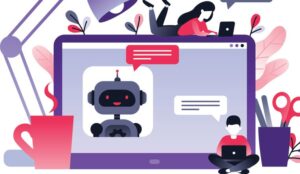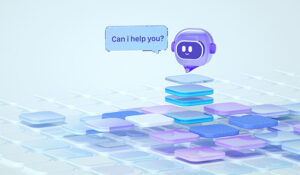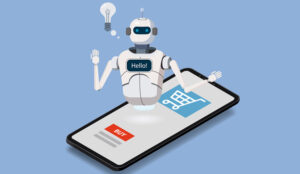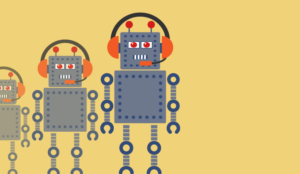Saurav Singh of Freshworks talks about chatbot technologies and the different ways you can use them.
59% of customers are more likely to buy when brands answer their queries in under a minute. And a study by Business Insider states that 45% of consumers don’t care if they interact with a live agent or a chatbot, as long as the service is effective, accurate, and fast.
So, whether you run a gift shop, an insurance office, or fall anywhere in between, a chatbot is an unstoppable force that can grab your customers’ attention at the right time to deliver the right message.
What Is a Chatbot?
A chatbot – as the name suggests, is software that can simulate a conversation (or chat) with a user. Chatbots run on scripted rules, which are only predefined questions for which the bot already has been programmed.
Apart from scripted answers, chatbots also use artificial intelligence, machine learning, and natural language processing to understand user intent and resolve common issues or escalate an interaction to a live chat agent.
Why Should You Start Using Chatbots Today?
Chatbots are supercharging customer support, and by the end of 2023, they will save 2.5 billion hours for businesses. But most businesses are using chatbots to improve their customer service.
Types of Chatbot Technology
1. Linguistic Based (Rule-Based Chatbots)
Sometimes referred to as ‘rule-based’, linguistic-based chatbots use ‘if/then’ logic to create basic conversational flows. Conditions for these chatbots can be created by looking at the words, their order, synonyms, or common ways they are phrased in a question, and then offering answer/s based on the rules assigned.
Although interactions with rule-based chatbots are quite specific, these chatbots can be further trained on different variations of the same question to ensure that questions with the same meaning receive the same answer.
2. Machine Learning (AI Chatbots)
AI chatbots are more complex than rule-based chatbots and tend to be more conversational, data-driven, and predictive.
These types of chatbots are generally more interactive and personalized than task-oriented chatbots and leverage natural language processing, or NLP, to understand and apply predictive intelligence to personalize a user’s experience.
AI chatbots are impressive, but developing machine learning algorithms and including predictive analyses is an expensive task for a lot of enterprises.
So instead of developing AI and ML technology all by yourself from scratch, it’s advisable to go for AI-powered chatbots that you can directly integrate with your website, CRM, or Customer Support Software.
3. Hybrid Model – Best of Both Worlds
Although rule-based chatbots and AI chatbots have several advantages, they have their own limitations when used individually.
A rule-based model is extremely efficient when it comes to answering common questions and following a specific set of rules. But when a question is not accounted for, the query is transferred to a human, as the bot is incapable of understanding the intent and providing a smart answer.
Similarly, AI chatbots have nailed the smart and predictive answers based on user intent, but it’s usually a time-consuming task to train them, the process requires a lot of data, and it cannot deliver 100% final resolution or even seamless interactions when sufficient data is not available.
And that’s where the hybrid approach comes into the picture. It combines the capabilities of both the models to deliver a more complex conversational AI chatbot solution.
The hybrid model uses the rule-based model to answer basic and repetitive queries and build a conversational system even without data.
At the same time, it uses machine learning and neuro-linguistic programming to learn from the data over time to make smart and complex conversational flows which are impossible to create using just rule-based chatbots.
13 Ways to Use a Chatbot (Apart From Answering Queries)
- Book tickets or appointment
- Find products, check inventory and recommend items
- Process return and exchange requests
- Confirm orders and track shipping
- Collect customer feedback efficiently
- Assign customer requests to support teams
- Register for webinar
- Promote products and roll out offers
- Execute drip campaigns
- Show demos and onboard customers
- Generate and qualify leads
- Build an email list more effectively
- Provide personalized shopping assistance
How to Build a Chatbot in 3 Easy Steps
Setting up a chatbot using Freshchat is as easy as 1-2-3 and you can set-up a basic flow even in your lunch break.
Here are 3 quick steps to get you started with Freshchat’s chatbots.
Step 1: Choose from custom bot/ answer bot – Signup for Freshchat, select from custom bot/ answer bot, and start building your own chatbot
Step 2: Create answers or custom flow – Identify the most commonly asked question. Create answers, custom chat flows, or add an agent to the conversation.
Step 3: Preview and publish – Preview the bot flow to check how it works in real time, and once you’re done, hit the publish button to make it live.
Final Thoughts
While rule-based chatbots and AI chatbots have their own place in customer service, a hybrid model takes the best of both worlds to leverage the true potential of chatbots.
And with Freshchat’s Answer bots and AI bots, you get the best hybrid-model chatbots without putting resources into developing the AI and ML technology.
Author: Robyn Coppell
Published On: 29th Jun 2020 - Last modified: 30th Jun 2020
Read more about - Guest Blogs, Freshworks





































